The uncharted depths of the ocean have always sparked curiosity in the human imagination—what really lives so far below the surface? What strange creatures can exist in such a cold, dark place? Mysteries and monsters of the deep have permeated myths and legends of the sea for centuries. And yet, what if the creatures featured in these fantastical tales were real? It turns out that there is at least one real-life sea creature so strange and terrifying, that perhaps it was the inspiration for sea monsters of legend: the frilled shark, a shark with a serpent-like body and a mouth full of 300 razor-sharp teeth.
Frilled sharks are one of the most bizarre and unique sharks on the planet—there is no other shark that even comes close to these ancient ocean creatures. In fact, many scientists and historians believe that legends of sea serpents and sea monsters may have come from the frilled shark or at least from its larger ancestors. Even the frilled shark’s scientific name “anguineus” is Latin for “snaky” or “snake-like.” Adapted to deep-sea living, these sharks look like mythical sea serpents, with large glass eyes and long, grinning mouths filled with rows of jagged teeth. Where does this shark live, and why does it have such a unique, prehistoric appearance?
A Living Fossil
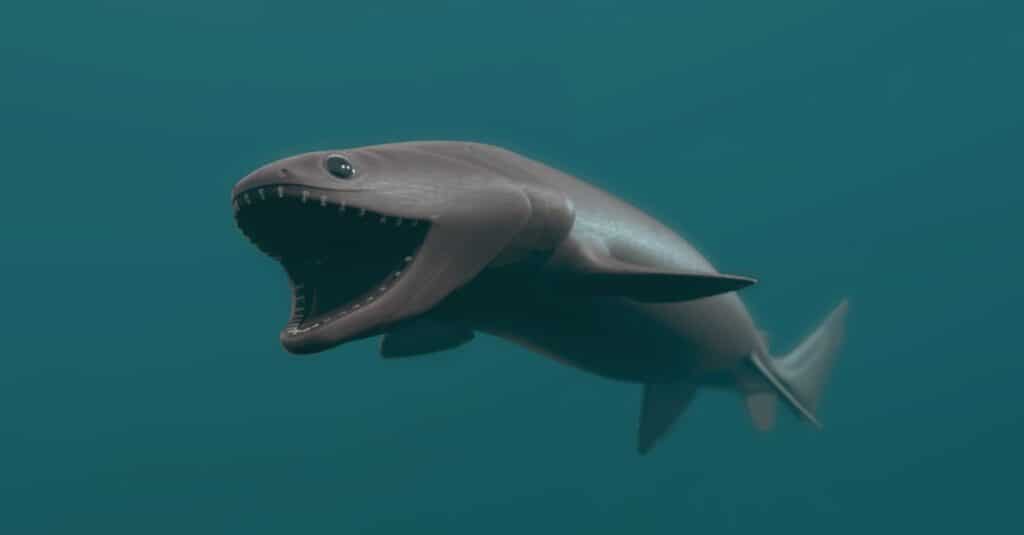
The Frilled Shark looks like a real-life legendary sea serpent.
©iStock.com/3dsam79
Frilled Sharks are some of the oldest living sharks on the planet today. These sharks have not changed much in the millions of years they have lived in the deep ocean, and so sometimes people call them “living fossils.” Frilled sharks are part of the Chlamydoselachus family, which dates back to at least 90 million years ago, and possibly even 300 million years ago. Today, there are only two species of the Chlamydoselachus family remaining: the Frilled Shark (Chlamydoselachus anguineus) and the African Frilled Shark (Chlamydoselachus africana).
The Frilled Shark (Chlamydoselachus anguineus) was first discovered in the late 1800’s. Even though scientists have known about its existence, the frilled shark is rarely seen by humans. So far, most of this shark’s encounters with humans were by accident when a shark was sick or became trapped in a deep-sea fishing net. The second species, the African Frilled Shark (Chlamydoselachus africana) was discovered in 2009 off the coast of South Africa, Namibia, and southern Angola. While it looks very similar to the first Frilled Shark, the African Frilled shark is much smaller and has a longer head.
Where Do Frilled Sharks Live?
Frilled sharks prefer cooler waters, living between the outer continental shelf and upper to middle continental slope. They live deep in the ocean, between 390-4,200 feet below the surface. These sharks have been found all over the world, off the coast of Scotland down to the coasts of West Africa. So far, however, they seem to be most common on the east coasts of Japan, New Zealand, and Australia. The African Frilled Shark lives off the coast of South Africa, Namibia, and southern Angola.
What Do Frilled Sharks Look Like?
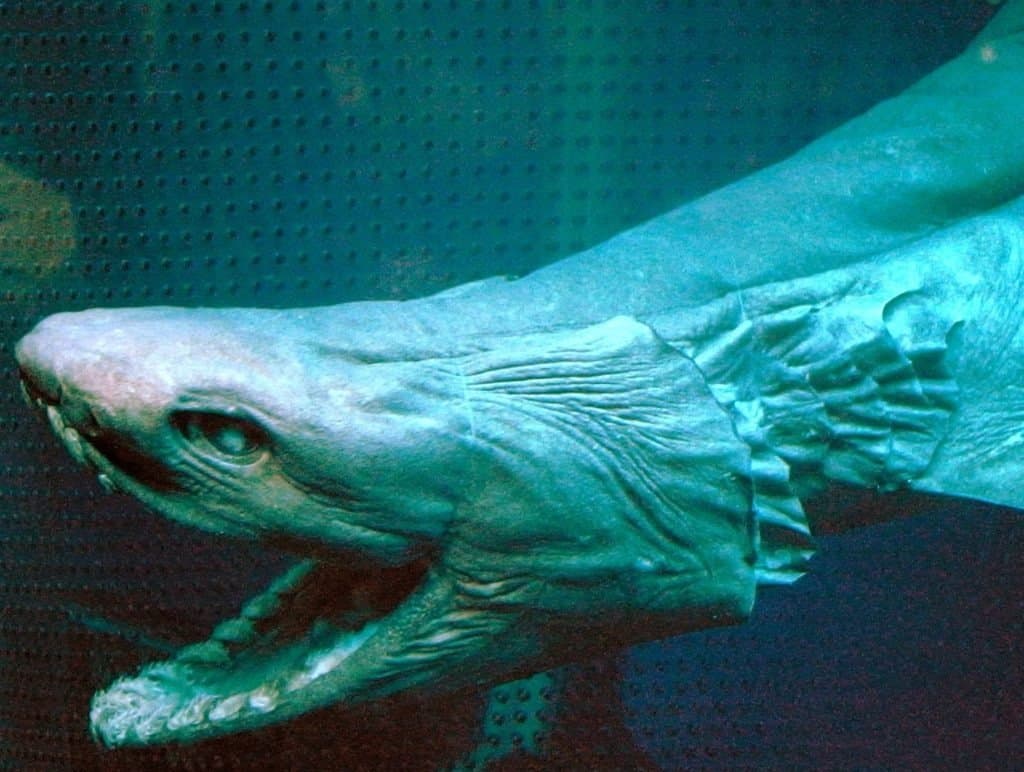
The largest Frilled Shark discovered was a female, measuring 6.6 feet in length.
©OpenCage / CC BY-SA 2.5 – License
Frilled sharks look less like sharks and more like ancient sea serpents. These sharks have long, serpent-like bodies and large triangular mouths. Frilled Sharks are 3-6.5 feet long with gray or dark brown eel-like bodies. Their name comes from the red “frilly” edged gill slits along their necks. While ordinary sharks have 5 pairs of gills, the frilled shark has 6. The first set of gills connects under the shark’s body, forming one long gill that looks like a collar.
The bodies of frilled sharks are uniquely adapted for living along the ocean floor. They have reduced skeletons, expansive stomachs, and lipid-filled livers that allow them to control their buoyancy. Scientists theorize that the shark’s physiology allows it to simply “hover” along the ocean floor.
Adding to their unique form, the mouth of a frilled shark is at the end of its long snout. Other sharks’ mouths are oriented downward below the snout, or at a 45-degree angle. The frilled shark, on the other hand, has a long mouth like a snake, just a 180-degree open and close hatch. These sharks swim with their mouths open when they hunt, possibly to lure fish in with their contrasting light-colored teeth against the dark ocean waters.
How Do Frilled Sharks Eat?
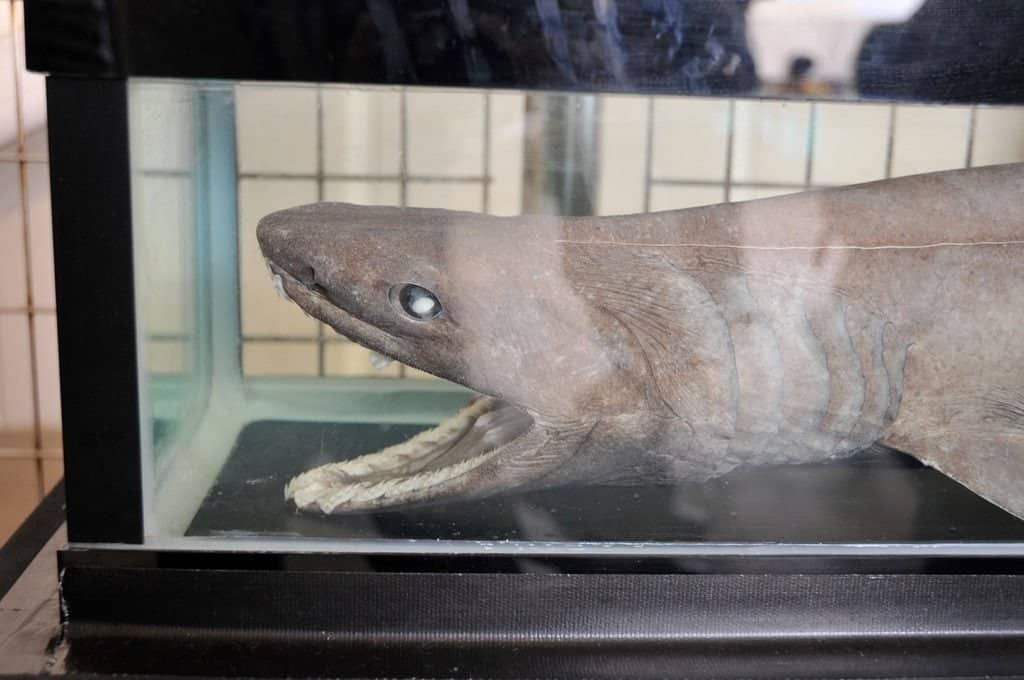
Some scientists think that the Frilled Shark may coil and strike at its prey like a snake.
©saname777 from Tokyo, Japan / CC BY 2.0 – License
Surprisingly, the frilled shark has relatively weak jaw strength and is a slow swimmer. A quick examination of its mouth, however, illustrates that this shark does not need speed or strength to survive—all it really needs are its spectacularly unique teeth! Frilled sharks have 300 teeth, widely spaced on the top and bottom jaws in 25 rows. These teeth are unlike any other sea creature we know of today. They are extremely sharp, shaped like small tridents pointing upward and inward like lethal hooks. These teeth are excellently adapted to snag soft-bodied, slippery prey like squid, keeping them from escaping like deathly rows of excessive Velcro. Prey can enter the mouth, but there is no way of getting out.
Frilled sharks swallow their prey whole. These sharks have expansive stomachs like a snake and can eat animals that are half their size. Squids make up 60% of their diet, but they eat bony fish and smaller sharks as well. A frilled shark caught off the coast of Japan had even swallowed an entire Japanese catshark!
Life Cycle and Reproduction
Frilled sharks breed throughout the year since they are deep enough in the ocean that the weather and seasons do not affect them. Female sharks will have 2-15 eggs at a time with an astounding gestation period of 3.5 years! These sharks are oviparous, so their embryos develop in drill-shaped eggs and hatch while still inside the mother. After the shark pups hatch, they remain inside their mother and feed on the yolk of their hatched eggs. Once the shark pups reach 20 inches in length, the mother births them out into the sea.
Conservation Status
The frilled shark is listed as a Near-Threated Species by the IUCN. These sharks have few threats because they live so deep below the surface of the ocean. However, frilled sharks are naturally rare, and are in danger of increased deep-sea fishing.
Other Deep Sea Sharks
Frilled sharks are not the only shark species that live in the deep ocean. Like the frilled shark, many other deep-sea sharks have some pretty unusual adaptations that allow them to live so far below the water’s surface. Take a look at a few examples of the unique sharks that live in the deep ocean.
Goblin Shark
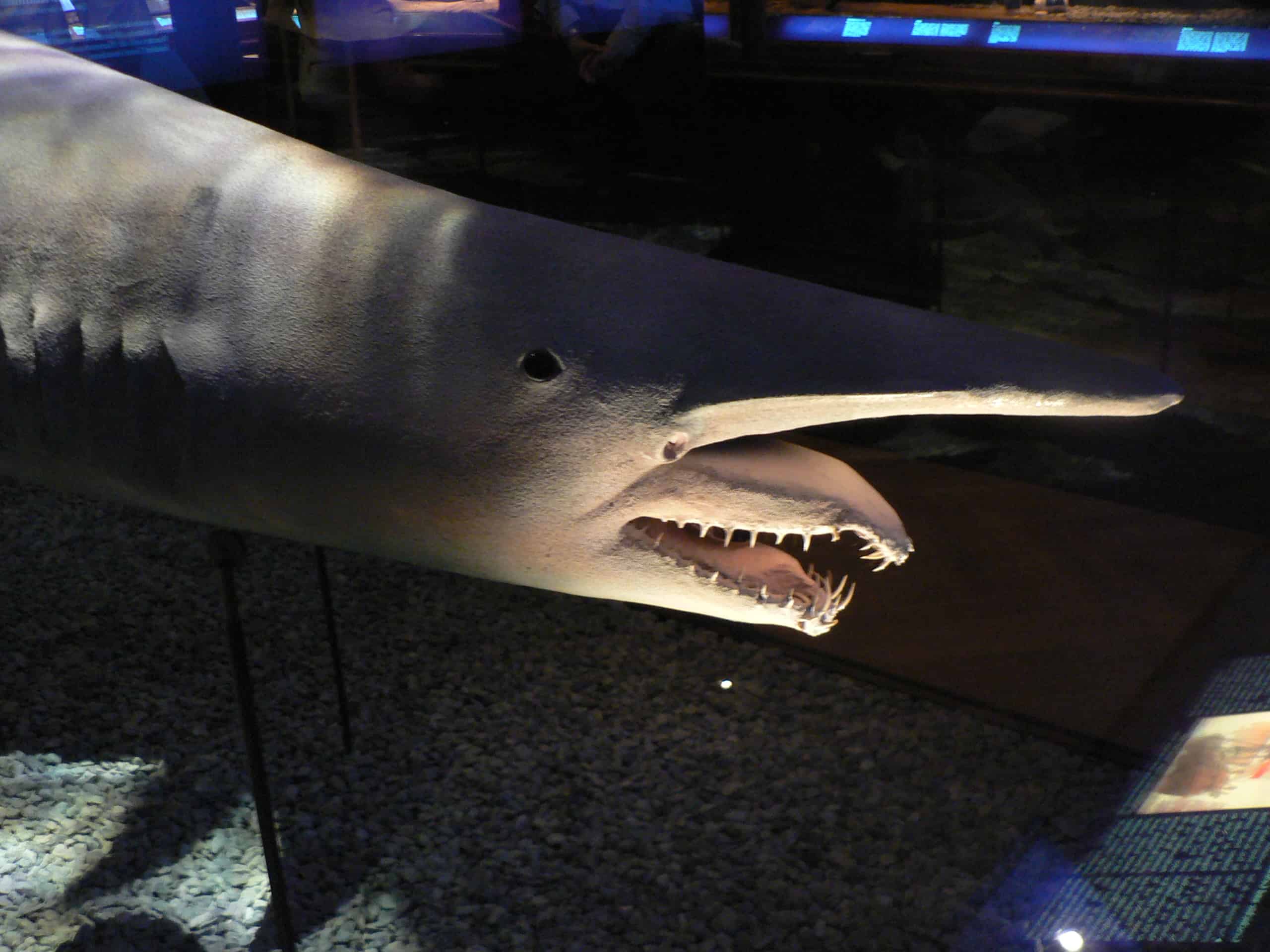
Goblin Sharks are scattered throughout the Atlantic, Pacific, and Indian Oceans.
©Peter Halasz / CC BY-SA 3.0 – License
Another species that holds the title of “living fossil” is the goblin shark. The goblin shark is the only remaining member of the Mitsukurinidae family, which dates back 125 million years ago. Goblin sharks have a rather unique appearance, resembling the goblins of Japanese folklore. These sharks are 10-12 feet long with a long, blade-like snout that shows off its scraggly fang-like teeth even when the shark closes its mouth. These sharks can thrust and extend their jaws three inches outside of their mouths to snatch escaping prey. Like the frilled shark, goblin sharks live on the ocean floor along continental shelves.
Cookiecutter Shark

The cookiecutter shark is one of the smallest species of shark, measuring only 16-22 inches long. These sharks have a long body with a stubby round snout and large bulging eyes. Cookiecutter sharks get their name from the way they hunt and eat. These sharks take large round bites out of their prey, leaving behind a round hole in the flesh like a cookiecutter. Because of their unique feeding style, these sharks can take bites out of a large variety of animals, even creatures bigger than they are. Many marine animals are found with these round scars left by cookiecutter sharks. Cookiecutter sharks prefer warmer waters, oscillating between 300 feet deep and 12,100 feet deep within a single day.
Greenland Shark
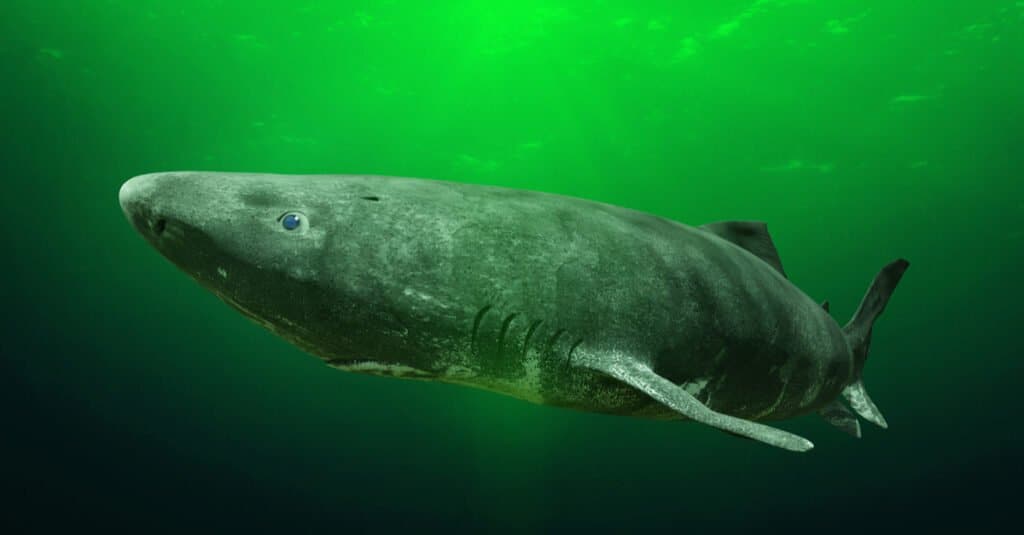
The Greenland shark can reach a maximum weight of over 2,000 pounds.
©Dotted Yeti/Shutterstock.com
The Greenland shark is a large species of shark, measuring between 8 and 23 feet in length. They have thick bodies with short, round snouts and small fins, giving them a unique appearance like a large torpedo. Unlike some of the other deep sea sharks, Greenland sharks have quite small eyes. Greenland sharks have an astonishingly long lifespan—they live for 400 years! These sharks prefer the icy cold waters of the North Atlantic Ocean, at least 7,200 feet below the ocean’s surface. Many Inuit legends, such as Skalugsuak, include the Greenland Shark.
Megamouth Shark
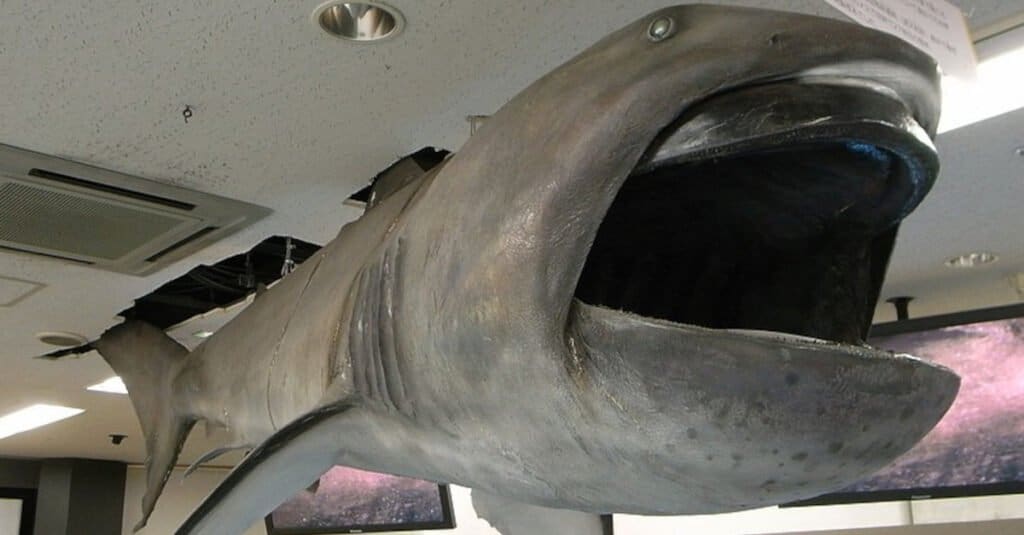
Megamouth Sharks are filter feeders like Basking Sharks and Whale Sharks.
©opencage / CC BY-SA 2.5 – License
The megamouth shark lives so deep below the surface of the ocean that humans rarely see it. This large shark can grow up to 18 feet long. Megamouth sharks are filter feeders and like their name, they have a very large mouth with tiny teeth. Because they are so rarely seen by humans, we do not know a lot about these sharks.
The photo featured at the top of this post is © OpenCage / CC BY-SA 2.5 – License / Original
Thank you for reading! Have some feedback for us? Contact the AZ Animals editorial team.






